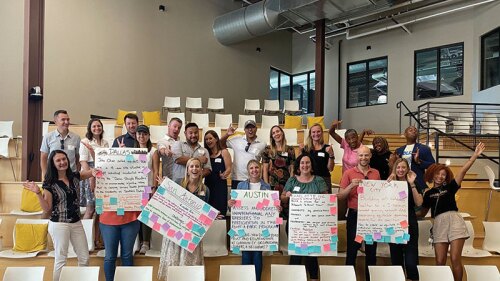ULI Global Chairman Randy Rowe has developed considerable expertise on autonomous vehicles and their implications for real estate and the built environment. As chairman and founder of Green Courte Partners, a Chicago-based private equity firm, and chairman of the Parking Spot, a parking platform recently acquired by Green Courte, Rowe has been at the forefront of debates about the impact autonomous vehicles—synonymous with driverless cars—will have on real estate investment, city planning and development, and the ability of people and goods to arrive at their destinations safely and efficiently.
There is little doubt that driverless cars are coming—with legacy automakers and upstart technology companies partnering with ride-hailing services such as Lyft and Uber to give consumers a preview. These services and apps to use them are growing in popularity across the world as consumers seek mobility alternatives to car ownership, conventional taxi services, and public transit systems that are overburdened.
Rowe discussed these issues and more in wide-ranging conversation with Dave Bragg, managing director at Green Street Advisors, a Newport Beach, California–based real estate advisory firm that recently released new research on autonomous vehicles, ride-hailing services, and real estate valuation. Their conversation, available via webinar, touched on several of the key issues for real estate and land use raised by the forthcoming transportation revolution. (Webinar registration is required.)
Reconfiguring and Reducing Parking and Roads Rowe predicts that surface and structured parking as well as road space will be transformed—and in some cases eliminated—by widespread use of driverless cars. According to Green Street, the United States has roughly 1 billion parking spaces, which account for up to 30 percent of total urban land area. This translates to 150 billion square feet (1.4 billion sq m) of land devoted to parking.
Converting even 50 percent of these spaces to another use presents a tremendous business opportunity for other forms of real estate while also offering the possibility of more parks, more affordable housing, and other benefits or enhancements to the public realm. Unfortunately, new parking spaces continue to be created across the United States because most municipal zoning codes still require them for project approval. As it happens, parking has never quite been able to pay for itself, being either free or heavily subsidized, according to Rowe.
“Even among paid parking, there is a significant portion of it that does not cover the cost of construction,” Rowe said in the interview with Bragg. “When we no longer have to plan projects around parking needs as much, it will free us up to do a lot of other things.”
On-street parking spaces likely will need to be converted to staging and queuing spaces for driverless vehicles to pick up passengers and goods. Also, the total road space taken up by cars will likely shrink because autonomous vehicles can drive closer together. Ultimately, the reconfiguration of roads for driverless cars could lead to vastly reconfigured land use patterns at the neighborhood, city, and regional scale.
According to Green Street’s research, different industry sectors will experience positive, negative, or mixed outcomes from the widespread adoption of driverless cars as land once dedicated to parking and roads becomes available.
A Suburban Resurgence? Thinking through the long-term consequences of driverless cars on real estate raises a number of counterintuitive ideas, according to Bragg and Rowe. Among those is the possible resurgence of suburban housing markets despite the current trend toward urbanization throughout the world.
According to Rowe, the key to lowering the cost and ensuring the safety of autonomous vehicles is to take human drivers out the equation. Once the service gets cheaper and the efficiency and safety of service improves, demand for autonomous vehicles will rise. A faster, cheaper option for commuting long distances may lead some consumers, particularly those with young families, to reconsider the suburbs, which typically offer more space for less money, plus better public schools.
“If you can commute much faster and much more cheaply and be productive in the vehicle the whole way, does that create more of a dynamic competition between urban and suburban in terms of where people live?” asked Rowe.
Rethinking Mass Transit Systems In a similar vein, transit-oriented development both in urban and suburban transit nodes could be at risk of depreciation if driverless vehicles offer a more convenient and cheaper mobility option. Mass transit is, in fact, quite expensive to build and operate, Rowe explained. Most systems require heavy subsidies, and cities across the United States are struggling to pay for the deferred maintenance and replacement of aging infrastructure. Transit is also not particularly flexible or tailored to the individual: consumers typically require another mode of transportation—walking, cycling, or bus service—to get from point A to B.
Instead of mass transit as we know it, fleets of autonomous vehicles for six to eight passengers that can be hailed by an app could fill a niche for a cost-effective and flexible mobility solution, Rowe said. The vehicle could adjust its route depending on the destinations of each passenger, ensuring that “a passenger actually gets directly from point to point instead of going node to node,” he said. “This could be done at a much lower cost and with a much more flexible method. That may be the future of mass transit . . . cheaper, more environmentally friendly, and more flexible.”
Listen to the full conversation between ULI Global Chairman Randy Rowe and Dave Bragg on Green Street Advisors’ Transportation Revolution recorded webinar. You will have to register for the webinar before listening.




